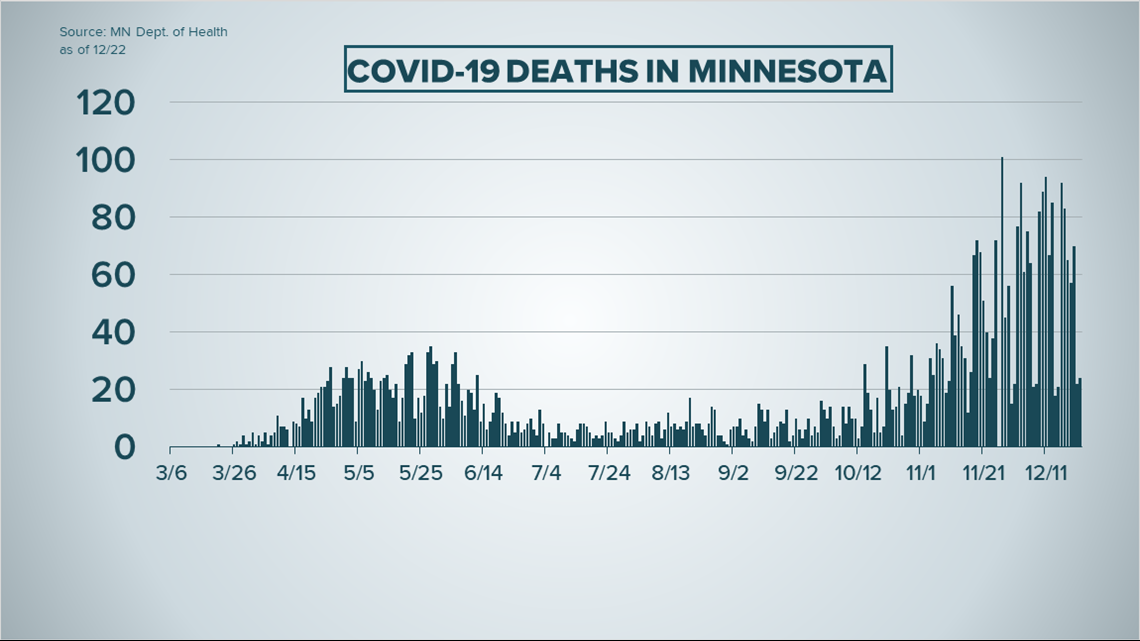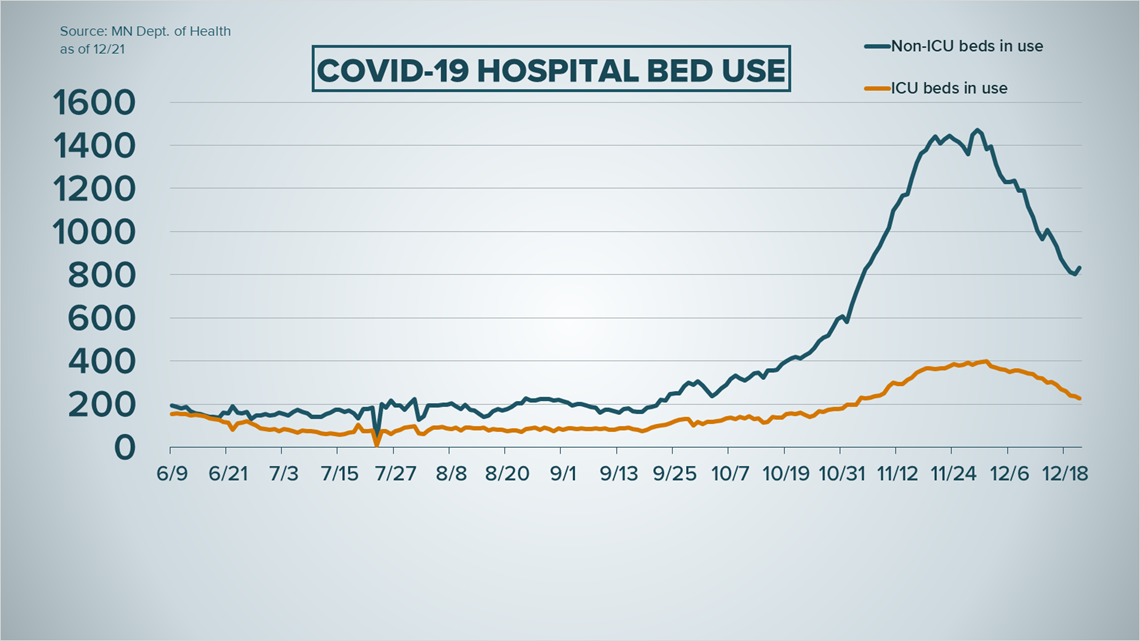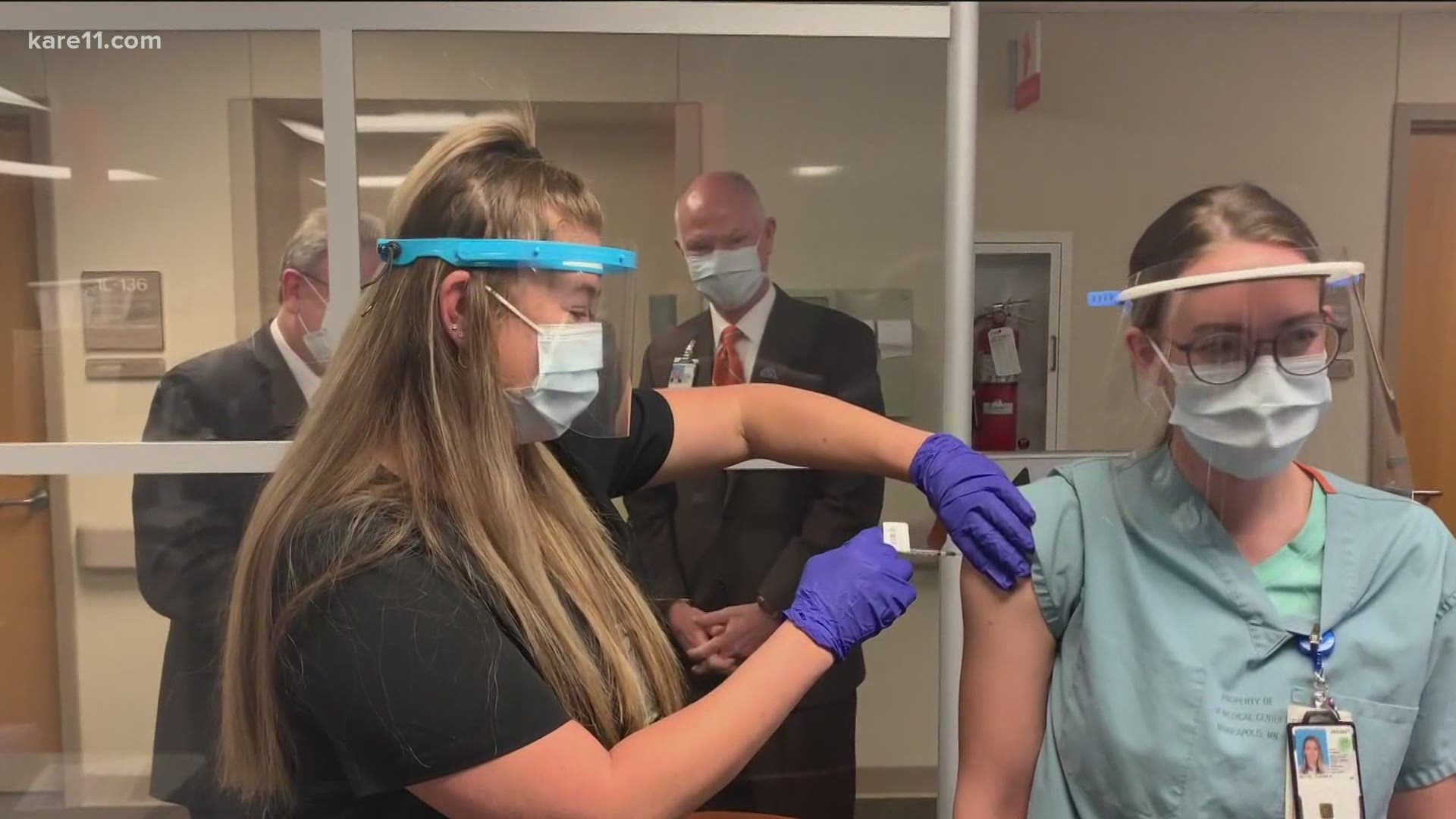ST PAUL, Minn. — Tuesday, Dec. 22
- Minnesota passes 400,000 cumulative COVID-19 cases
- Downward trend in new Minnesota cases continues; under 2,000 for second day in a row
- Wisconsin COVID-19 deaths spike to 120
- Pres. Trump expected to sign new $900 billion COVID relief bill in coming days
- Minnesota testing sites to close Dec. 24, Dec. 25, Dec. 31 and Jan. 1
- December is already Minnesota's deadliest month of the pandemic
- BioNTech CEO has “scientific confidence” vaccine will work on new strain of virus spreading in UK
2 p.m.
Governor Tim Walz and Minnesota heath officials held a live media call to discuss vaccine distribution and new cases.
"This is going to take time... but we'll get there," Walz said of the state's effort to distribute COVID-19 vaccines.
The Minnesota Department of Health says it's expecting 94,800 doses of the Moderna vaccine that will primarily be reserved for long-term care residents and staff - this after getting nearly 47,000 doses of the Pfizer vaccine last week.
Health officials expect all of the state's first top-tier recipients will get both doses of a vaccine by the end of January.
"It's not quite as optimistic as we had thought initially, but I think we're in a pretty good place considering we're talking about just three weeks of vaccine availability," said Kris Ehresmann, the Minnesota Department of Health infectious disease director.
Gov. Walz said the situation in the state is showing signs of improvement, but that Minnesotans can't let their guards down for the holiday season. He pointed out Minnesota's new benchmark: 400,000 cumulative cases of COVID-19.
"We’re disheartened to report that we have passed yet another grim milestone of 400,000 cases today," said Health Commissioner Jan Malcolm in a news release. "We reached that number, unfortunately, about as quickly as we expected we would when we hit 300,000 and saw cases climb rapidly in November. We fully intend to do what we can to make sure the next milestone is slower in arriving, if at all."
Malcolm also spoke on the call and said despite the recent downward trend, MDH saw an uptick in hospital beds in use due to COVID-19 in the numbers reported Tuesday.
Malcolm said the state's latest test positivity rate is 8.4% - almost a 2% drop from one week ago. Like the governor, however, she added that Minnesotans can't let their guards down yet.
"As tempting as it is to say, oh good, the numbers are going in the right direction, that's because we're doing the right things and we really need to stay the course," said Malcolm.
Meanwhile, Wisconsin's Department of Health Services (WDHS) reported 120 deaths Tuesday, the most single-day deaths since the pandemic began. The total number of deaths in Wisconsin rose to 4,545, which is approximately 1% of those testing positive for the virus.
Health officials reported 2,403 new cases Tuesday, bringing the total number of cases statewide to 461,015.


On Tuesday, Dec. 22 Gov. Evers announced that his administration has struck a deal with Vault Medical Services to provide free at-home COVID-19 saliva tests, according to the Associated Press. Anyone interested in a test can order one through the state Department of Health Services website starting immediately. Users must collect a sample as a Vault testing supervisor looks on via Zoom and then mail it back to a Vault lab using a prepaid label that comes with the kit. Results will take 48 hours to 72 hours.
Wisconsin health officials say a total of 20,355 people have been hospitalized from the coronavirus since the start of the pandemic, about 4.4% of the total number of people who have been diagnosed with the virus.
Of the confirmed cases in Wisconsin, 19% involve people between the ages of 20 to 29, 16% are between 30 and 39, 15% are between 50 and 59, and 14% are 40 to 49. An estimated 11% are between 10 and 19, and another 11% are between 60 and 69.
As of Tuesday, Milwaukee County reported the largest number of confirmed cases with 81,526, along with 942 deaths. Waukesha County has reported 32,697 confirmed cases and 310 deaths, Dane County has reported 31,867 confirmed cases and 163 deaths, and Brown County has reported 25,317 cases and 160 deaths.
11 a.m.
New cases of COVID-19 continue a downward trend, according to numbers released Tuesday by the Minnesota Department of Health (MDH).
An additional 1,714 coronavirus cases were recorded in the past day, based on results from a relatively low testing volume of 32,195 tests (30,051 PCR, 2,144 antigen). State health officials consider a positive PCR test a confirmed COVID case, while a positive antigen test is considered a probable case.
The new COVID cases bring Minnesota to a new benchmark, breaking the 400,000 milestone with 401,011 cases reported since the start of the pandemic. That number includes 12,338 antigen tests.
MDH says 24 more Minnesotans have died of the virus, bringing fatalities to 4,896. Of that number 3,176, or 65% of them are linked to long-term care or assisted living settings.


Currently 1,060 hospital beds across the state are being used to treat COVID patients, with 228 of those beds in ICU. In the Twin Cities metro, hospital capacity remains tight with 5% of non-ICU beds available, and 7.4% of ICU beds available for use. Total hospitalizations have risen to 20,816 since the onset of COVID-19, with 4,449 of those patients needing care in the ICU.
Young adults make up the largest grouping of Minnesota's coronavirus cases, with people between the ages of 20 and 24 accounting for 41,088 cases and three deaths, followed by those 25 to 29 with 35,974 and six deaths.
The largest group of deaths involves people from 85 to 89, with 929 deaths in 5,291 confirmed cases.
Hennepin County has recorded the most COVID activity with 83,520 cases and 1,321 deaths, followed by Ramsey County with 35,897 cases and 636 deaths, Dakota County with 29,019 cases and 256 deaths, and Anoka County with 28,113 cases and 295 fatalities.
Cook County has the least COVID activity with 101 cases and no deaths.


Monday, Dec. 21
3 p.m.
Minnesota Department of Health officials held a media call to discuss Minnesota's vaccination efforts, COVID-19 restrictions and the virus's impact on holiday celebrations.
Commissioner Jan Malcolm began the call discussing the state's declining seven-day positivity rates, which has dipped below the high-risk level. The current seven-day positivity rate is at 8.9%.
"There genuinely are pieces of good news in these data," Malcolm said. "As what will be a massive vaccination effort slowly ramps up, we've seen a downward trend in cases and hospitalizations."
Malcolm also acknowledged the positive impact the new safety measures have had on slowing the spread, including those guidelines that were in place over Thanksgiving.
"We want to acknowledge that and thank Minnesotans for their actions, which have clearly created some very important respite for our health systems and hospitals as they have really been working so hard at maximizing capacity at every turn," Malcolm said.
Malcolm shared some statistics from a new study that was published in the Journal of the American Medical Association last week. It found that among Americans between the ages of 25 and 44, between March through the end of July, there were almost 12,000 more deaths than would have been expected based on historical norms. Malcolm says that trend continued into the fall.
The study says that it was estimated that around 154,000 deaths were expected in that age group for 2020, but that number was surpassed in November and is expected to reach 170,000 deaths by the end of the year due to COVID-19.
"We have a tendency to think of COVID-19 as a disease primarily, or almost exclusively, very serious for older adults, but this is a reminder that adults in these younger age groups can still be severely impacted by COVID-19," Malcolm said.
According to Malcolm, Minnesota surpassed 5 million COVID-19 tests over the weekend, saying it's a major milestone in terms of the state's testing capacity ability.
As the holidays approach this week, Malcolm continued to urge Minnesotans to be safe and vigilant by avoiding any larger gatherings with family or friends.
"If you are planning to see family or friends outside of your own immediate household, please do consider getting tested," she said. "We know young people are more likely to be asymptomatic carriers and have an increased risk of exposing others without knowing it, so we really encourage folks to take advantage of the many testing options that are available to you."
Testing sites will be closed Dec. 24 and Dec. 25, as well as Dec. 31 and Jan. 1.
MDH Infectious Disease Director Kris Ehresmann discussed the COVID-19 vaccine rollout across the state. According to Ehresmann, the Minnesota Vaccine Allocation Advisory Committee will meet again next week and again in January, with the official recommendations for prioritization in rollout Phase 1B coming out on Jan. 18.
"As you know, we want to make sure that all Minnesotans have access to the COVID-19 vaccine, and that's our commitment, but because we don't have as much vaccine as we want initially, we do need to make prioritizations," Ehresmann said. "Depending on the weekly shipping amount that we receive, we hope to be through vaccinating Phase 1A by the end of January, but that is entirely dependent on the allocation that we receive from the federal government."
2 p.m.
Gov. Tim Walz held a roundtable discussion to encourage high schoolers to apply for Pandemic Unemployment Assistance (PUA).
"Let's be clear," Walz said on the virtual roundtable on Monday. "All of these young people who are working are paying taxes and being part of the system, too."
Lt. Gov. Peggy Flanagan said she knows what it is like to work while trying to balance the demands of high school, and that situation is even more stressful now for families who depend on student workers.
"I know that the stress and anxiety that this pandemic has created for everyone has impacted all of you all the more so," Flanagan said.

